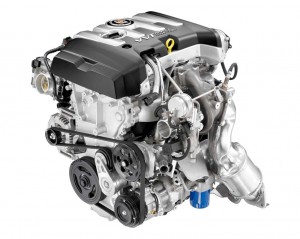
GM is betting the consolidation will help speed to market new powertrains, such as the turbo 2.0-liter Cadillac engine shown here.
General Motors is consolidating its far-flung engine and transmission operations in the Detroit suburb of Pontiac, and backing the move with a $200 million investment at its Global Powertrain Engineering Headquarters.
The move, which will create 400 new jobs in the Motor City, is part of a broader $1.5 billion effort to rejuvenate its operations in the US. Earlier this week, GM announced plans to invest $600 million at its massive Fairfax assembly plant in Kansas.
At the Global Powertrain Engineering center, the money will be used to build a new 138,000 sq.-ft. test wing, which is expected to be completed during the second half of 2014 and lead to the elimination of four leased buildings in three states.
“These moves will help our entire Powertrain team work more effectively across the organization to develop the powertrain technologies we need to build the world’s best vehicles for our customers around the world,” said Sam Winegarden, GM vice president of Global Engine Engineering.
The new test wing is part of GM’s efforts to bring advanced, fuel-saving powertrains to market faster and less expensively by reducing development time. The entire 450,000 sq.-ft. powertrain facility is one of the largest and most technically advanced development centers of its kind in the world, GM claims.
Winegarden said the technical center’s state-of-the-art facilities allow engineers to test engines under extreme conditions, including cold ambient temperatures, high RPMs, and repetitive starting and stopping, to assure world-class durability, reliability and quality.
The expansion will enable the company to consolidate work being done at four locations in Michigan, Indiana and California, helping to reduce development timing for GM’s next-generation advanced propulsion technologies.
When the moves are complete, GM will have added approximately 400 jobs to the Pontiac campus.
Under the expansion plan, engineering development work currently being done at leased facilities in Wixom, Mich.; Castleton, Ind. and Torrance, Calif., will move to Pontiac. Also, GM R&D’s Propulsion Systems Research lab in Warren, Mich. will relocate to the Pontiac campus.
GM previously announced that work being performed at its hydrogen fuel cell facility in Honeoye Falls, N.Y., would be shifted to Pontiac in mid-2013. Hydrogen technology has been on the back burner in recent years but interest in fuel cell stack systems has suddenly surged back to the forefront in light of new joint ventures pairing BMW and Toyota, as well as Daimler, Nissan and Ford.

GM, Ford and Chrysler have always lacked sufficient dyno labs to do efficient advanced engine development, thus they have out-sourced some of this work. The net benefit was lower costs, faster engine development and a lot of good design and engineering knowledge gained from outside the corporations. While some folks do not like out-sourcing, i.e. Unions, taping into the extensive knowledgebase outside of the Big Three is smart business and mutually beneficial IME.
There is little doubt outsourcing will continue, Jorge. But makers have also struggled to define so-called “core competencies,” which can vary by maker. Powertrain has been clearly defined by most automakers as core, especially with the tough emissions and mileage standards they face. So, no surprise to see such a move. That said, GM — and competitors — clearly recognize they can’t do it all alone. I expect to see them continue to work with outside vendors. In fact, if the new BMW-Toyota and Nissan-Daimler-Ford fuel cell partnerships are any indication expect to see GM expand its alliances, where necessary, as well.
Paul A. Eisenstein
Publisher, TheDetroitBureau.com
I have no doubt that outsourcing will continue. That doesn’t however mean alliances with other car makers on technology development. The Big Three have simply not had some of the in-house resources or expertise that they need to do a lot of the advanced engine development in a timely manner. Technology changed a lot faster than the Big Three’s development programs.